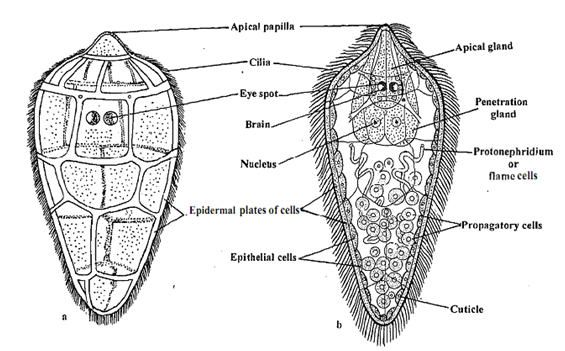Explain the Miracidium larva?
Miracidium is the first stage larva that comes out from the fertilized egg.
i) Miracidium is an oval, microscopic, flattened larva which appears conical in shape.
ii) Body is uniformly covered with epidermal plates. There are 21 plates arranged in 5 rows. First to fifth row contain 6,6,3,4,2 epidermal plates respectively.
iii) Anterior end of the larva is projected into a conical lobe called apical papilla which acts as a boring organ.
iv) Internal structures of the miracidium which can be seen include, the triangular sac called apical gland attached to the apical papilla, a pair of bag-like penetration gland located on each side of apical gland (also called cephalic glands), two eye spots, two flame cells, rudimentary gut and germ cells.

Miracidium larva comes out from the egg shell of the fertilized egg by eroding the operculum with the help of proteolytic enzyme. It is the first larval stage in the life cycle of F. hepatica. It is a free swimming stage in fresh water. Miracidium larva swims freely in water for 4-30 hours in search of a suitable intermediate host which may belong to the genus Limnea or Planorbis. If the larva does not come in contact with a suitable host it dies. Miracidium larva enters the snail and destroys its tissues. It penetrates through the pullnonary chamber; during this period it loses its cilia, epidermal plates, brain, eye spots, apical and penetration glands as well as primitive gut.